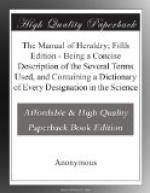The chief is an ordinary terminated by an horizontal line, which, if it is of any other form but straight, its form must be expressed; it is placed in the upper part of the escutcheon, and occupies one third of the field.
Ex. Argent, on a chief, gules, two mullets, sable.
[Illustration: Chief]
Any of the lines before described may be used to form the chief.
[Illustration: Chief]
Ex. Argent, a chief, azure, indented.
The chief has a diminutive called a fillet; it must never be more than one fourth the breadth of the chief.
[Illustration: Fillet]
Ex. Or, a chief, purpure, in the lower part a fillet, azure.
This ordinary may be charged with a variety of figures, which are always named after the tincture of the chief.
It may be necessary to inform the reader that, in describing a coat of arms, the general colour of the shield or the field is first described, then the honourable ordinaries, their tinctures, then the object with which they are charged. We shall have to remark more particularly on the order of describing ordinaries, tinctures, and charges on coats of arms, when we treat of the rules of heraldry; but the student might have been confused if this brief direction had been omitted, as we shall have to describe every shield of arms in the same order.
The pale is an honourable ordinary, consisting of two perpendicular lines drawn from the top to the base of the escutcheon, and contains one third of the width of the field.
[Illustration: Pale]
Ex. Azure, a pale, or.
The pale may be formed of any of the lines before described; it is then called a pale engrailed, a pale dancette, &c.
The pale has a diminutive called the pallet, which is one half the width of the pale.
[Illustration: Pallet]
Ex. Argent, a pallet, gules.
The pale has another diminutive one fourth its size; it is called an endorse.
[Illustration: Endorse]
Ex. Argent, a pale between two endorses, gules.
The pale and the pallet may receive any charge; but the endorse is never to be charged with any thing.
THE BEND.
The bend is an honourable ordinary, formed by two diagonal lines drawn from the dexter chief to the sinister base, and contains the fifth part of the field if uncharged; but if charged with other figures, the third part of the field.
[Illustration: Bend]
Ex. Argent, a bend, vert.
The bend has four diminutives, viz. the garter which is half the breadth of the bend.
[Illustration: Garter]
Ex. Argent, a garter, gules.
The cotice which is the fourth part of the bend. Cotices generally accompany the bend in pairs; thus a bend between two cotices is said to be cotised.




